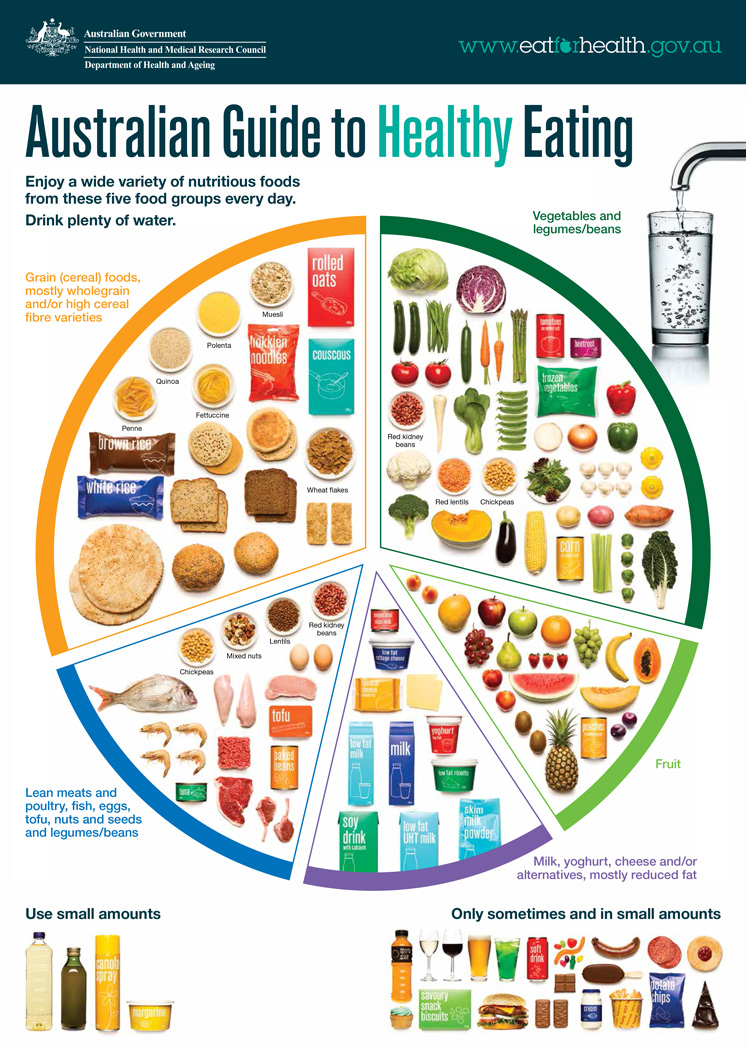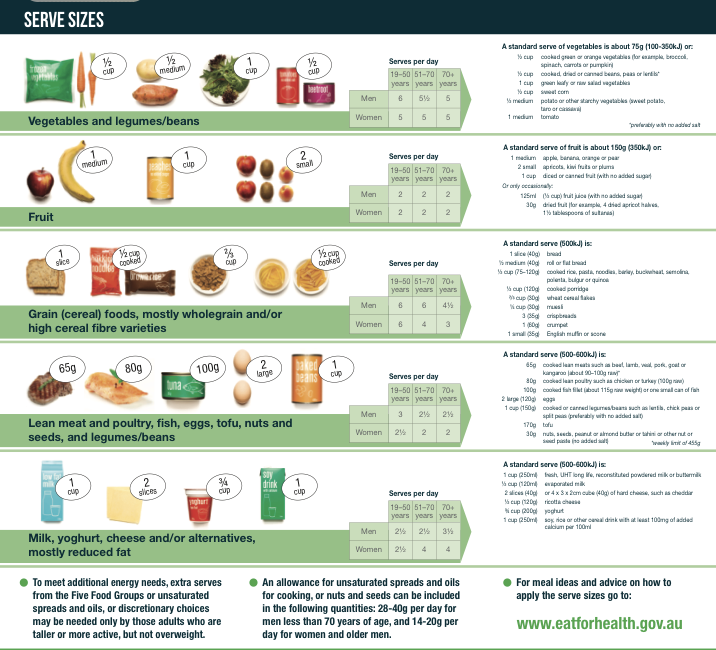Are you a nutrition nerd?
Have you ever wondered about the national nutrition guidelines in other countries?
Just recently I reviewed Japan’s dietary guidelines to look for insights as to why the Japanese live so much longer than we do.
I enjoyed the activity so much that I jumped at the opportunity to collaborate with Australian dietitian Stefanie Valakas in bringing you an analysis and review of the Australian Food Guide also known as The Australian Guide For Healthy Eating.
The coolest part? Stefanie , also known as The Dietologist, will be sharing HER views on OUR Canadian Food Guide over at her website.
I highly recommend heading over there once your done here ( or right now!) to read what she has to say.
I believe that foreign insights into our food policies are insightful, intriguing and quite valuable to us here at home.
I know I learned alot from reading her views.
Never underestimate the impact an outsider’s perspective can have!
Dietetics In Australia
Let me start by saying I have a GREAT deal of respect for dietetics and nutrition practice in Australia having made a number of meaningful relationships with Australians via Instagram.
I know just how well valued the profession is over there, and I truly appreciate that.
I also have to tip my hat to all of the social media dietitians down under ( also known as APDs- Accredited Practicing Dietitians) for doing such a brilliant job.
And a final thank you for Australian group Dietitian Connection, for being open to sharing today’s post with all of their readers.
The Australian Food Guide ( The Australian Guide To Healthy Eating)
I strongly believe that this cross-cultural collaboration is a valuable activity for the simple reason that the diet and disease issues we face in Canada are quite similar to those faced in Australia.
I will be assessing the Australian Guide To Healthy Eating based both on “reasonability” and comparisons to the Canadian Food Guide.
For those of you reading today’s article with no idea what the Canadian Food Guide looks like, have a look at it here.
If you are interested in my own personal critique and analysis of Canada’s Food guide, you can find that here.
The Australian Food Guide AKA the Australian Guide To Healthy eating, is included below.


What I Like About It
#1 It Uses REAL food photos to represent serving size – I personally think the greatest strength of the Australian guide is that it uses real food pictures to represent serving sizes, which is an extremely important consideration.
I didn’t realize how much potential this had until I saw it and it made me realize that the use of graphics in our Canadian food guide may be more aesthetic than practical.
At the end of the day, real food looks like real food and not a cartoon.
#2 It Does a Reasonable job of representing relative importance of each food group: Although I have one very specific complaint to make in the next section, I will say that a circle is great visual choice for representing the relative role each food group should play in a healthy diet.
I’d like to say it passes the “reasonable dietitian” test, whereby a reasonable dietitian from anywhere in the globe can look at that circle and say “fair enough” that’s a decent representation of good dietary balance.
#3 It Suggests MOSTLY whole grains: I love that the Australian guide comes right out and says it wants you to have MOSTLY whole grains.
In Canada, we cop out a bit and suggest a whole grain intake of at least 50%.
#4 It Offers Nuts and seeds as an alternative to oil use: One of the very cool things the Australians do is tell their people that the recommended 2-3 tbsp of oils ( which our food guide also has) can be interchanged with nuts or seeds ( look at the bottom part of the second image).
This may seem like a minute distinction but here’s why I think it’s so valuable:
Unlike oil, nuts/seeds contain both fibre and protein which means they contain not only healthy fats but also help keep you feeling full.
This is not to mention their impressive magnesium and antioxidant content.
Given that a reduction in calories and an increase in fibre and magnesium is a goal for most people, this suggested swap/alternative makes so much sense.
What Could Be Improved Upon
#1 It could give even more prominence to vegetables – Veggies are the undisputed champions of healthy eating. Given their low calorie, high nutrient nature , and the fact that most people don’t eat nearly enough, I tend to believe that vegetables should be the most well represented component of any national food guidelines.
Although I certainly believe that whole grains are right up there as well, I think that I am bit put off by the representation that grains and vegetables are visually represented as equally important parts of a healthy diet.
The other two qualms I have with the Australian Guide For Healthy Eating are also flaws that are shared with the Canadian Food Guide, and not necessarily Aussie specific. No offense mates!
#2 It lacks a bit of recognition for dairy alternatives: I have nothing against dairy but it doesn’t seem quite right that, at a time when dairy alternatives are so readily available, that only soy milk finds itself pictured in this category. For me, this tells the reader that if you don’t like soy milk ( the only dairy alternative presented) you NEED to drink cow’s milk to have achieve a balanced nutrient intake. This sentiment, of course, is inaccurate and misleading. Canada’s Food guide shares the same issue.
#3 It does not separate meat & meat alternatives: I’m an omnivore and I enjoy eating my steak just as much as I enjoy my tofu. With that being said, I think we need to stop bundling meat-alternatives ( such as tofu, legumes, nuts & seeds) with meat.
Although yes both foods contain similar nutrients in some respects ( such as protein, iron etc), there are worlds of difference in other components such as antioxidant concentration and fibre content.
Also, the last time I checked nut and seed intake is associated with a reduced risk of all cause mortality and I’m not quite sure we can say the same about red meat.
My proposed solution is to divide the meat/alternative group into two distinct entities to help the public understand that foods such as legumes, tofu, nuts and seeds (and perhaps fish) offer health benefits beyond the usual meat selections and should be incorporated daily.
An addendum would have to be added that additional meat-alternative intake could replace the need for meat intake, but not vice versa, so as to respect vegetarians and vegans.
Again, Canada’s Food Guide shares this same flaw.
What I’m On The Fence On
#1 Legumes in two food groups: One interesting thing about the Aussie guide is that they actually include legumes in both the meat alternative AND vegetable category.
I think there are pros and cons to this but obviously the Aussies want you to eat your legumes and I guess I can’t complain because I do too!
The only issue being, again relating to my detracting from vegetables complaint earlier, is that the message could be misconstrued such that somehow lentils and kale are “equivalent foods”, which they aren’t quite.
#2 Including estimated calorie values: Another interesting component of the Aussie guide is that they give general guidance on the calorie values in a serving of food.
We don’t do this in Canada and I’m conflicted over the utility of this component.
On the one hand, the average citizen has the right and need to be informed and make informed decisions because calories do matter.
On the other, including calorie values could potentially detract and distract from the overall message of enjoying an intuitively carried out diet that is balanced and varied.
Final Thoughts
The Australian Guide To Healthy Eating offers some valuable insights and I particularly like their use of actual food photos, an emphasis on mostly whole grains and the strategy of suggesting nuts/seeds as an option in place of vegetable oil usage.
It does share some of the flaws that our guide has, and also has some interesting differences which I’m not 100% sure how I feel about.
Ultimately though, it is no better or worse than our own food guide, simply different.
It certainly passes my “reasonability test” for being a well put together document to guide nutrition on a population level.
I want to close by thanking Stefanie for coming up with this great idea to collaborate and I feel that it is a truly fun and valuable exercise to assess the ways in which other countries advise their people.
If you have not already, please head over to her page now to have a look at an Aussie’s opinion on the Canadian Food Guide.
I hope you guys enjoyed reading our work as much we enjoyed writing it!
Until next time,
Andy De Santis RD MPH
More About Stefanie Valakas APD




